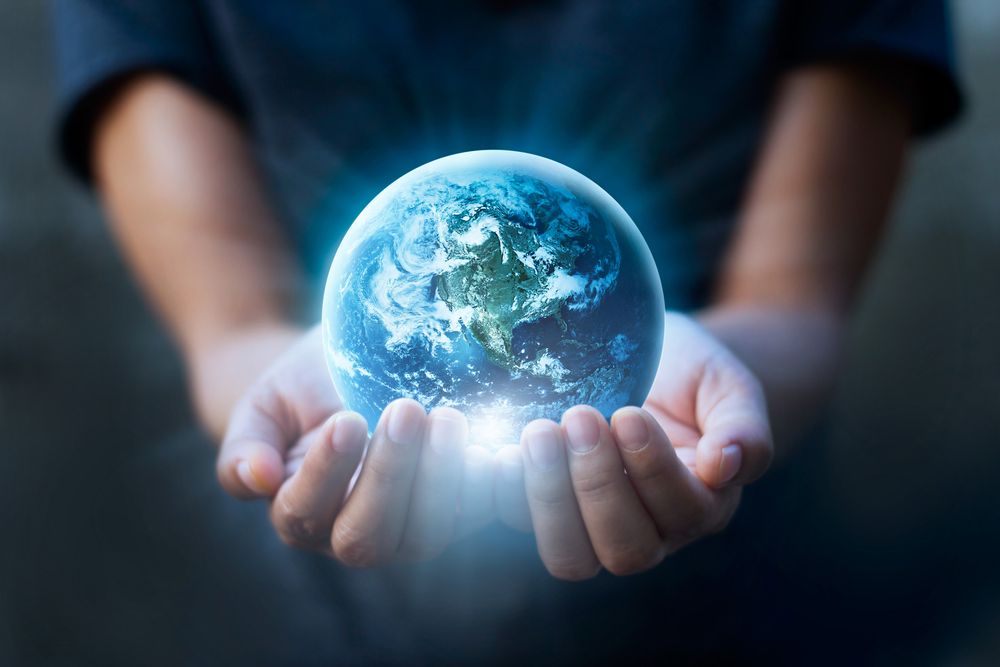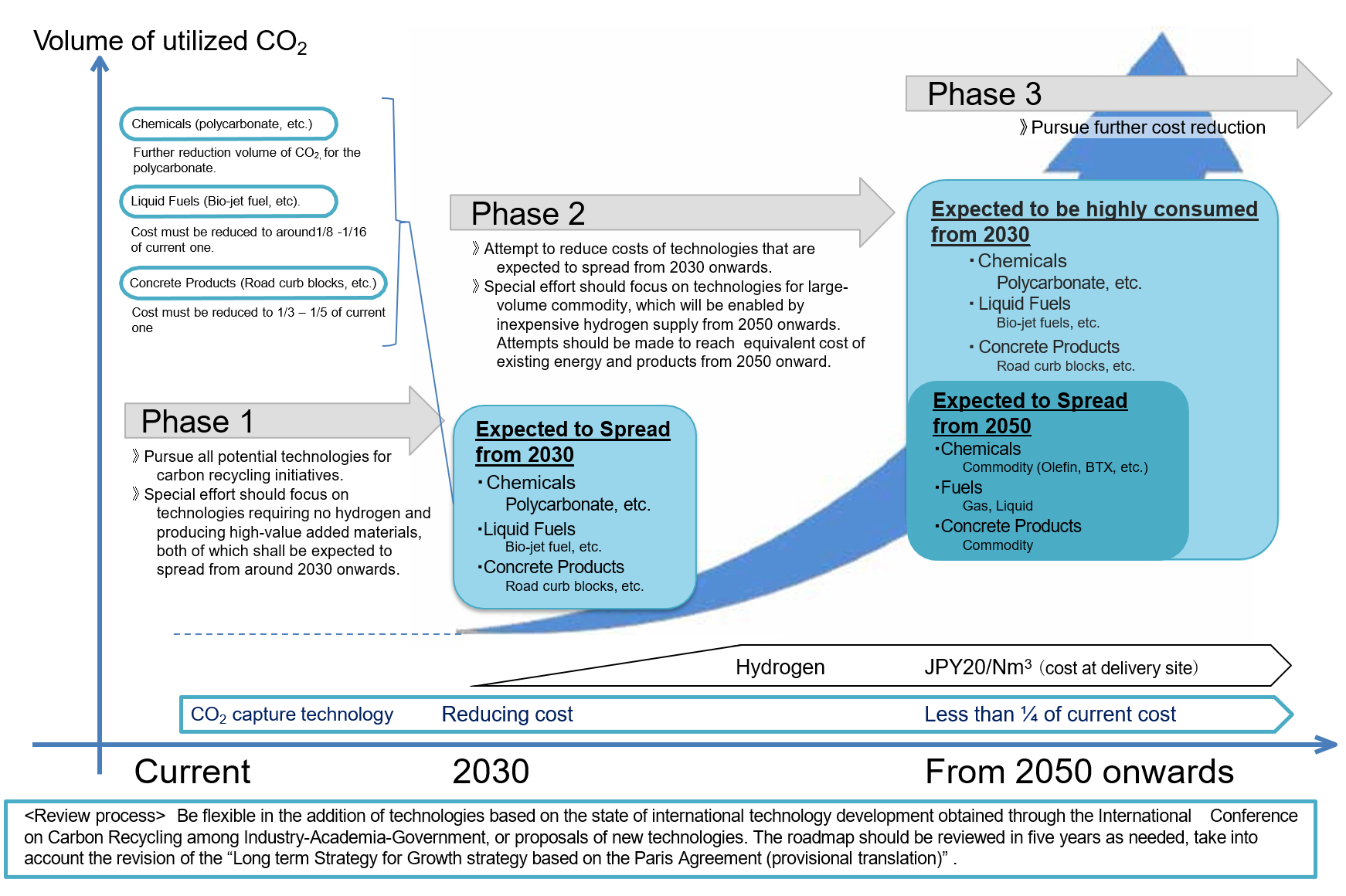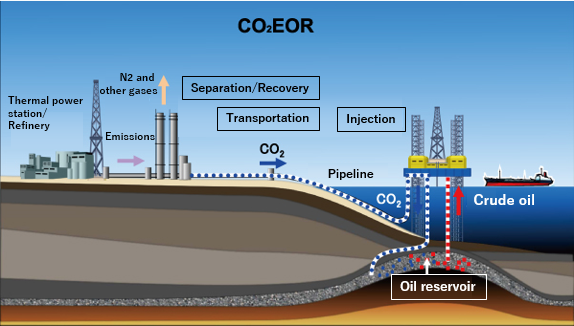Japan’s New International Resource Strategy -Resource development and utilization with due consideration given to climate change
(in provisional translation)
(English ver.) 2021-01-13

This series of articles presents Japan’s new “international resource strategy” established in March, 2020. Japan’s basic energy policy, referred to as “3E + S”, aims to simultaneously achieve Energy security, Economic efficiency and Environmental suitability with the underlying premise that Safety is always the primary concern. What measures is Japan taking based on this new strategy while maintaining its 3E+S policy? This article will focus on Japan’s strategy in relation to climate change.
Climate change response
The Paris Agreement, an international framework for tackling climate change, came into force in 2016. Following this, major countries have announced their plans and visions toward a “decarbonized society”. “Decarbonization” is a process of reducing greenhouse gas (GHG) emissions toward achieving a balance between artificially emitted GHG and naturally absorbed GHG by forests, etc. In other words, it aims to balance GHG emitted by economic activities against that absorbed by vegetation for photosynthesis.
Japan aims to reduce GHG emissions, a cause of climate change, by 23% in FY2030 and by 80% in FY2050, in comparison with the FY2013 level. On the other hand, the global energy demand is expected to increase mainly in emerging nations in Asia and Africa. In some areas of these countries, residents can hardly have access to electricity, and they still burn firewood for cooking. In the future, “fossil fuels” such as oil and coal will take over in these areas because of the stability of supply and relatively low prices, leading to the continued growth of global demand for these fuels.
Japan upholds a “virtuous cycle of environment and growth” as its concept of climate change response. In order to pursue this concept under such circumstances as described above, it is necessary to make all efforts to promote various potential technologies worldwide, in particular CO2 utilization technologies, not to mention the reduction of CO2 emissions by improving energy efficiency and disseminating renewable energy. Japan, as a country with advanced energy-related technologies, should actively deploy such technologies to the rest of the world.
In order to accelerate climate change response, the new strategy upholds the following efforts that Japan should make.
Advancing Carbon Recycling
“Carbon Recycling” is an approach to curb CO2 emissions by utilizing CO2 as a “resource” to produce materials and fuels. Technological development is currently underway based on the “Roadmap for Carbon Recycling Technologies” published in 2019. The roadmap sorted out challenges which technological development would face, and set important milestones. CO2 applications include chemicals, fuels and minerals, part of which are projected to disseminate on the markets from 2030. To this end, domestic research and development capabilities will be enhanced.
Roadmap for Carbon Recycling Technologies

Moreover, there is a possibility that thermal power generation, if combined with Carbon Recycling technologies, will make a competitive energy source with virtually “zero emission”, which captures CO2 for reuse. The roadmap stresses the importance of collaborating with countries such as the USA, Saudi Arabia and Australia in advancing research and development. It also recommends that Japan actively deploy its Carbon Recycling technologies to the rest of the world toward advancing decarbonization globally. For this purpose, Japan aims to play a leading role in organizing international rules as well as raising awareness of Carbon Recycling in the international communities.
Climate-conscious energy development
In resource development to extract oil, gas and minerals, it has now become essential to take appropriate measures to deal with environmental issues including climate change. There is an increasing number of companies which conduct resource development combined with various decarbonization measures giving due consideration to environmental issues. While Carbon Recycling is one of those measures, there is another method to utilize CO2 referred to as “CO2 Enhanced Oil Recovery”. It is to capture CO2 emitted from plants such as thermal power stations and inject it at pressure into the underground of an oil field to substantially enhance the recovery rate of crude oil.
How CO2EOR works

In addition, there is a technology referred to as CCS (Carbon dioxide Capture and Storage) to separate and remove CO2 for underground containment, which is currently being tested. Furthermore, afforestation and offshore wind power generation are being practiced in the vicinity of resource development sites as options for decarbonization measures.
However, taking decorbonization measures in resource development could lower the overall economics of the project. The new strategy offers incentives encouraging companies to advance efforts for resource development. For instance, Japan Oil, Gas and Metals National Corporation (JOGMEC), as an effort to alleviate economic burdens borne by companies, offers reduced debt guarantee rates for oil and gas field development projects which are combined with decarbonization measures.
Expanding the usage of fuel ammonia
Ammonia, which does not emit CO2 when it is burned, is expected to be a promising fuel that can reduce CO2 emissions substantially by replacing fossil fuels. Ammonia is made from hydrogen. If hydrogen is produced by electricity generated by renewable energy, or by fossil fuels combined with CCS technology, ammonia will become completely “carbon-free” energy that emits no CO2 in the entire process from production to consumption.
In addition to its characteristics described above, ammonia has the advantage of being easier to disseminate as a fuel. It has been widely utilized for producing fertilizers and other materials with its global supply chain already established.
Fundamental research on fuel ammonia was conducted from 2014 to 2018 as one of the projects of the “Cross-ministerial Strategic Promotion Program (SIP)” which was established by Cabinet Office for creating innovation in science and technology. As ammonia contains nitrogen, there is a possibility that it will emit a large amount of nitrogen oxide (NOx) when combusted. However, this research confirmed that NOx emissions, a cause of air pollution, could be suppressed. The new strategy aims to advance the utilization of fuel ammonia toward further reducing CO2 emissions. To this end, demonstration projects will be conducted for potential technologies whereby fuel ammonia is co-fired with gas or coal for thermal power generations.
This series of articles has presented Japan’s new international resource strategy. Based on this strategy, Japan will not only strive to secure its own energy requirements, but also make efforts to enhance energy security from a global perspective with due consideration given to climate change.
Division in charge
About the article
Policy Planning Division, Natural Resources and Fuel Department
About Special Contents
Research and Public Relations Office, Policy Planning and Coordination Division, Commissioner's Secretariat
![]() The original Japanese text of this article; Click here
The original Japanese text of this article; Click here